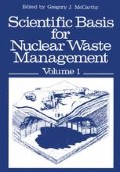Abstract
Migration of radionuclides in ground water has been identified as the most likely pathway from a deep geologic nuclear waste repository to the biosphere. An important mechanism in retarding nuclide movement in ground water is sorption, a term which is used herein to encompass all mechanisms pertinent to interactions (which include ion exchange, absorption, and precipitation) between nuclides and the geomedia. Water exiting a repository at the WIPP site would encounter halite in the repository horizon, polyhalite and anhydrite beds, and finally sandstone and dolomite formations which are the upper bound of the repository. To a rough approximation, the concentration of a given nuclide per unit mass, C(solid), sorbed on a solid mineral phase can be related to the concentration per unit volume, C(liquid), in the liquid phase by the relation:
where Kd is generally referred to as the distribution coefficient, with units of ml/g. The use of the term Kd implies an equilibrium state for a given reaction and is used, in that sense, in the mathematical modeling of long term radionuclide migration (1). In the interaction of a nuclide with a complex mineral assemblage, equilibrium conditions may not apply, and the symbol Kd is used as an empirical value applying only to the particular set of conditions used.
This work supported by the United States Department of Energy (DOE), under Contract AT(29-l)-789.
A DOE Facility.
Access this chapter
Tax calculation will be finalised at checkout
Purchases are for personal use only
Preview
Unable to display preview. Download preview PDF.
References
I. Y. Borg, R. Stone, H. B. Levy, and L. D. Ramspott, “Information Pertinent to the Migration of Radionuclides in Ground Water at the Nevada Test Site,” Part I. Review and Analysis of Existing Information. Rept. UCRL-52078, Lawrence Livermore Laboratory, Livermore, CA, 216 pp. (May 1976).
S. J. Lambert and J. W. Mercer, “Hydrologie Investigation of the Los Medanos Area, Southeastern New Mexico, 1977,” Rept. SAND77–1401, Sandia Laboratories, Albuquerque, NM, 58 pp. (January 1978).
R. G. Dosch and A. W. Lynch, “Interaction of Radionuclides with Geomedia Associated with the Waste Isolation Pilot Plant (WIPP) Site in New Mexico,” Rept. SAND78-0297, Sandia Laboratories, Albuquerque, NM, 49 pp. (June 1978).
Author information
Authors and Affiliations
Editor information
Editors and Affiliations
Rights and permissions
Copyright information
© 1979 Plenum Press, New York
About this paper
Cite this paper
Dosch, R.G. (1979). Radionuclide Migration Studies Associated with the WIPP Site in Southern New Mexico. In: McCarthy, G.J., et al. Scientific Basis for Nuclear Waste Management. Springer, Boston, MA. https://doi.org/10.1007/978-1-4615-9107-8_47
Download citation
DOI: https://doi.org/10.1007/978-1-4615-9107-8_47
Publisher Name: Springer, Boston, MA
Print ISBN: 978-1-4615-9109-2
Online ISBN: 978-1-4615-9107-8
eBook Packages: Springer Book Archive

